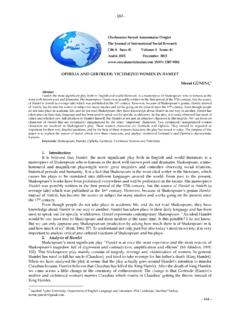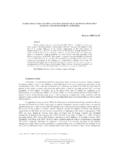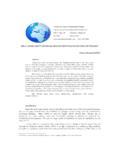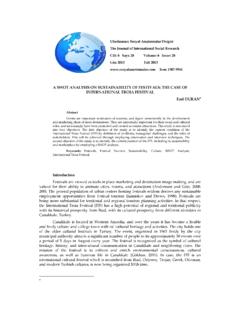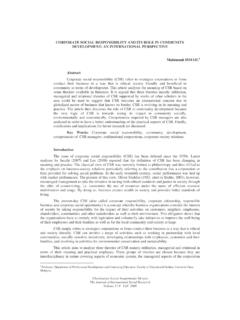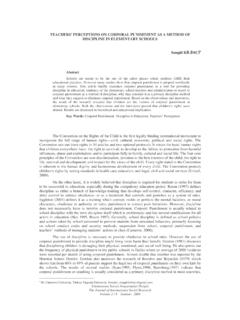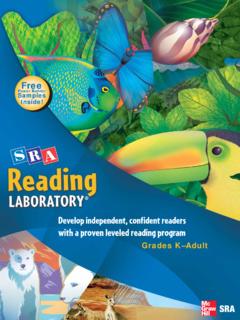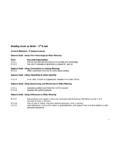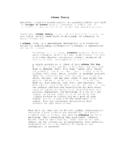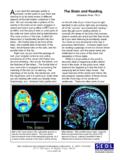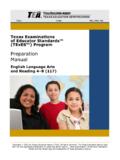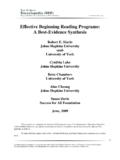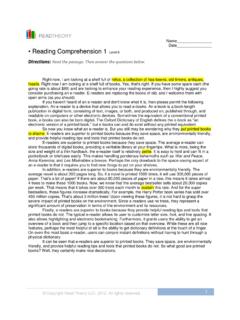Transcription of HOW TO ENHANCE READING COMPREHENSION …
1 HOW TO ENHANCE READING COMPREHENSION through metacognitive strategies Yrd. Do . Dr. Feryal UBUK U Abstract This article aims at presenting a study of the teacher trainees in the English department who have received instruction in metacognitive awareness for READING COMPREHENSION . Metacognition or "thinking about thinking" involves the awareness and regulation of thinking processes. metacognitive strategies are those strategies that require students to think about their own thinking as they engage in academic tasks. Within this study, students have been taught metacognitive strategies for READING in a five-week program they have joined voluntarily.
2 The students have used the READING logs to reflect on their own thinking processes as they have been engaged in READING tasks. The purpose of the study is to determine the effectiveness of systematic direct instruction of multiple metacognitive strategies designed to assist students in comprehending text. Specifically, the READING COMPREHENSION and vocabulary achievement of 130 third-year university students has been investigated to determine whether instruction that incorporated metacognitive strategies has led to an increase in the READING COMPREHENSION of expository texts. In addition, the investigation is also designed to determine the impact of the metacognitive strategies on vocabulary.
3 Key Words: READING , vocabulary COMPREHENSION , metacognitive strategies , teacher trainees Metacognition One of the first definitions of metacognition comes from Flavell (1976), who describes it as one s knowledge concerning one s own cognitive processes and products or anything related to them . He also asserts that metacognition includes the active monitoring and consequent regulation and orchestration of information processing activities (Flavell 1976: 232). Baird (1990:184) uses these ideas to provide the following succinct formulation: Metacognition refers to the knowledge, awareness and control of one s own learning.
4 metacognitive development can therefore be described as a development in one s metacognitive Dokuz Eyl l niversitesi, E itim Fak ltesi, Ingiliz Dili Egitimi. Uluslararas Sosyal Ara t rmalar Dergisi The Journal Of International Social Research Volume 1/2 Winter 2008 84 UBUK U, Feryal abilities, the move to greater knowledge, awareness and control of one s learning. Metacognition (Flavell 1979; Kuhn 2000:178; Veenman 1993: 1997; O Neil and Abedi 1996) refers to two aspects, namely the students self-awareness of a knowledge base in which information is stored about how, when, and where to use various cognitive strategies and their self-awareness of and access to strategies that direct learning ( monitoring difficulty level, a feeling of knowing).
5 This awareness is developmental and lies on a continuum. Proficient readers use one or more metacognitive strategies to comprehend texts. There are three main aspects of metacognition: metacognitive knowledge, metacognitive monitoring, self regulation and control (Pintrich, Wolters and Baxter 2000). The first group consists of cognitive learning strategies which the learner uses to regulate the process of knowledge acquisition. These include, for example, elaboration strategies such as the building of links to prior knowledge, or memory strategies such as note taking. The second group consists of metacognitive control strategies . Central here are activities like the planning and monitoring of learning activities, the evaluation of learning outcomes and the adaptation to varying task demands and (unexpected) difficulties, for example, an increase in directed efforts.
6 In addition to these two groups, which are dominant in research and crucial for the learning process, a third group of strategies in the model developed by Pintrich and Garcia (1994) is dedicated to resource management. These strategies are concerned with the control of the general conditions associated with learning, for example, time management and management of the learning environment. The following two key questions students need to ask themselves are crucial in terms of metacognitive awareness and knowledge: 1. What do I want out of this? (What are my motives?) 2. How do I propose going about getting there? (What are my strategies ?) (Biggs & Moore 1993) Another important metacognitive model set forth by Winne and Hadwin (1998) has four basic stages: task definition, goal setting and planning, enactment, and adaptation.
7 Their model suggests that the learner generates a perception of what the task is and the available resources, constructs a plan for addressing the task, enacts study strategies , and makes changes to his or her cognitive structure based on perceptions of performance. Pintrich (2000) synthesized the work of a variety of self-regulation theorists into a general framework which includes: (a) forethought, planning and activation; (b) monitoring; (c) control; and (d) reaction and reflection. How To ENHANCE READING COMPREHENSION through metacognitive strategies Uluslararas Sosyal Ara t rmalar Dergisi The Journal Of International Social Research Volume 1/2 Winter 2008 85 Pintrich s model suggests that the learner develops perceptions of the task demands, engages in metacognitive monitoring, selects and implements cognitive strategies that are appropriate for the task demands, and evaluates task performance while reflecting on the effectiveness of the cognitive strategies .
8 These models all suggest an interaction between personal factors and situational factors such as task and test demands, the coordination of goal setting and metacognition, the use of cognitive learning strategies , and self reflection. READING and Metacognition The current understanding of READING strategies has been shaped significantly by research on what expert readers do ( , Bazerman 1985; Pressley & Afflerbach 1995). These studies demonstrate that successful COMPREHENSION does not occur automatically. Rather, it depends on directed cognitive effort, referred to as metacognitive processing, which consists of knowledge about and regulation of cognitive processing.
9 During READING , metacognitive processing is expressed through strategies , which are procedural, purposeful, effortful, willful, essential, and facilitative in nature (Alexander & Jetton 2000 : 295). The reader must purposefully or intentionally or willfully invoke strategies (Alexander & Jetton 2000: 295), and does so to regulate and ENHANCE learning from text. through metacognitive strategies , a reader allocates significant attention to controlling, monitoring, and evaluating the READING process (Pressley 2000; Pressley, Brown, El-Dinary, & Afflerbach 1995). Taraban,R. Kerr, M, and Rynearson, K (2004:69) state that prior research supports the view that college students select and use READING strategies that are oriented toward success in academic tasks.
10 Wade, Trathen, and Schraw (1990) recruited 67 college volunteers who read a 15-page passage at the 11th-grade level followed by a recall test. This type of task, involving extensive READING and subsequent recall, is typical of many college assignments. At eight separate points during READING , participants were asked to provide a retrospective report of their READING strategies . The authors identified 14 strategies from the data, which they called tactics. These were separated into three types, by consensus. One type was text-noting tactics, and included highlighting, underlining, circling, copying key words, phrases or sentences, paraphrasing in notes, outlining and diagramming.
